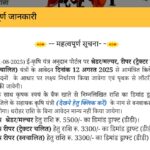Of these, 35 million are the unemployed who are actively seeking work while 17 million are those who, though willing to work, are not actively seeking it, CMIE said. “India needs to immediately provide employment to the 7.9% who are in the unemployment rate or 35 million in December 2021 who were not employed and they were actively looking for employment,” CMIE said in its weekly analysis.
Of these, 35 million are the unemployed who are actively seeking work while 17 million are those who, though willing to work, are not actively seeking it, CMIE said.
“India needs to immediately provide employment to the 7.9% who are in the unemployment rate or 35 million in December 2021 who were not employed and they were actively looking for employment,” CMIE said in its weekly analysis.
“It is worth investigating why such a large number of women who are willing to work are not actively applying for work or making other efforts in finding work. Is it lack of availability of jobs or is it lack of social support for women to join the labour force,” it argued.
Citing the data from the World Bank, CMIE said that the World Bank had pegged the global employment rate at 55% in the pandemic hit 2020 or 58% in 2019 while that of India stood at a low of 43%. However, CMIE pegged India’s employment rate at 38%.
“India’s unemployment problem is not reflected in its unemployment rate. Its problem is the low employment rate and its discouraged young female labour force,” CMIE said.
According to CMIE, India’s path to prosperity is in finding employment for nearly 60% of the population. “To reach global employment rate standards India needs to employ an additional 187.5 million people,” it said, adding that given the current employment of the order of 406 million that is a tall order.



















